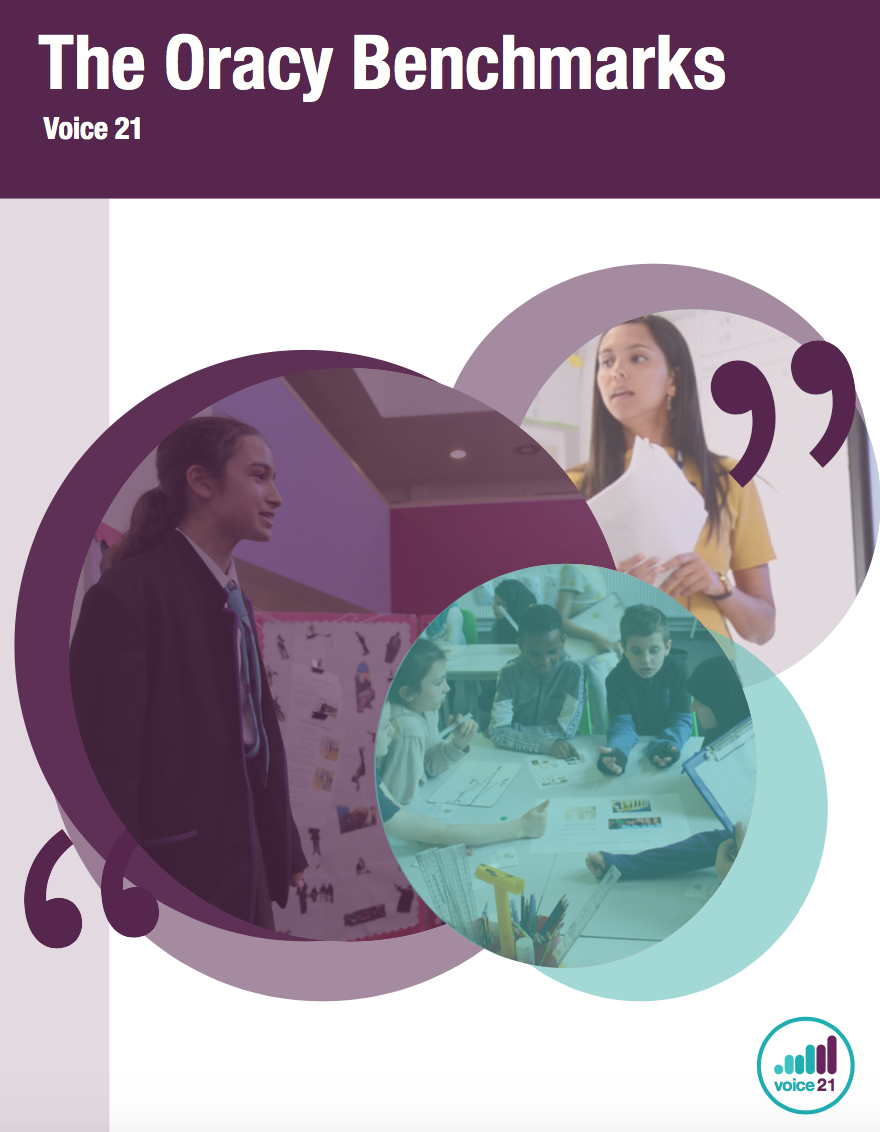December 2019

In the context of increasing recognition of the need for oracy – the establishment of the APPG for Oracy chaired by Emma Hardy MP, the recent Forgotten Third report which calls for speaking and listening to be made an integral part of the curriculum across all subjects, the growing numbers of schools and teachers engaging with Voice 21, and even the School’s Minister speaking out about it’s virtues – guidance is needed to better understand what high quality oracy education looks like and what the steps are to achieving it.
Below, Alice Stott, Director of Impact & Innovation, Voice 21 and co-author of The Oracy Benchmarks, reflects on our decision to write them and how they seek to bring clarity to an area of education that holds so much, often untapped, potential.
Oracy is a slippery idea – its both everywhere and nowhere in a school. How to teach it well can feel elusive, and yet talk is right there, in front of you, in whatever classroom you go into, in whatever phase or subject, from EYFS all the way through to A level further maths.
We’ve spent the past three years working with schools and teachers up and down the country, learning from practice and trialling ideas and approaches to embedding oracy. With the publication of the Oracy Benchmarks, we feel confident in saying ‘this is what a high quality oracy education looks like’ and hope that they serve as practical guiding principles for teachers and school leaders.
So what does oracy look like when done well? Our 2016 report the State of Speaking in Our Schools described oracy as having ‘untapped potential’. Despite a majority of teachers (68%) and headteachers (84%) believing that oracy was important for their students, it identified that most did not know where to go to to improve their oracy teaching and learning.
We saw that there was a gap between what schools know, and the oracy education they are then able to provide for their students. In writing the benchmarks, we’ve sought to identify the practices that unleash the potential power of oracy. We want the Oracy Benchmarks to support teachers and schools to operationalise and realise much of what they already know: that oracy supports key agendas such as the teaching of reading and writing, their well-being and confidence, and transition into the world of work.
The challenge therefore has been how to empower teachers and schools to take what they already know, and apply that in school. We hope that the Oracy Benchmarks will support teachers and schools to do just that – identifying the active ingredients, the things that make a real difference, when it comes to teaching oracy and support them to implement them in their school.
In doing so, we have tried to avoid creating a tick-list mentality but rather to recognise that there are all sorts of ways schools can arrive at each benchmark. The Oracy Benchmarks define the end destination, but don’t dictate particular routes to get there. We want schools and teachers to have to think about what reaching each benchmark will mean in their context, rather than trying to squeeze themselves into a one-size fits all approach.
We also took a decision to create both teacher and school oracy benchmarks. We have done this because we know the power of individual teachers to create the climate in their classroom, who make choices everyday about what they teach and how to teach it based on the students in their room. This is as much true for oracy as it is for anything else – and so we knew that the level of complexity, thought and detail needed to teach oracy effectively required a set of benchmarks focused specifically on classroom practice.
The school oracy benchmarks reflect the different levers available to school leaders, who want to ensure every student in their school benefits from an education in oracy. Again, school leaders are continually making choices about the type of education they will provide their students; the School Oracy Benchmarks articulate what these choices look like when it comes to a high quality oracy education.
While the teacher and school benchmarks can be read individually, they are most meaningful when read alongside each other, reflecting the fundamental relationship between the knowledge, capability, confidence and actions of individual teachers and the expectations, ethos and success of the school as a whole. The teacher benchmarks feed the school ones – they establish fundamental ideas which are they scaled up and extrapolated to a whole school level.
We hope that the Oracy Benchmarks bring clarity to an area of education that holds so much, often untapped potential and serves as a call to action to strengthen your school’s oracy provision.
We also hope that it acts as a stimulus for dialogue in your school: why does oracy matter for your students? How can you enable every student to find their voice? What good practice is already happening? Posing questions like these will support intelligent implementation of the Oracy Benchmarks, connecting them to your school’s context, exploring existing practice and strengths in order to inform actions going forward.
Read the full report and the benchmarks poster here.
© 2024 Voice 21. Voice 21 is a registered charity in England and Wales. Charity number 1152672 | Company no. 08165798